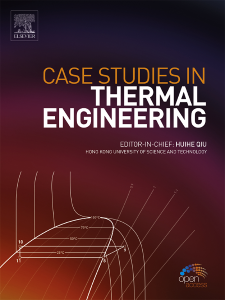Performance evaluation of supercritical CO2 Brayton cycle with two-stage compression and intercooling
IF 6.4
2区 工程技术
Q1 THERMODYNAMICS
引用次数: 0
Abstract
Due to its small structures and high energy efficiency, the Brayton cycle using supercritical carbon dioxide (sCO采用两级压缩和中冷技术的超临界二氧化碳布雷顿循环性能评估
由于结构小、能效高,使用超临界二氧化碳(sCO2)的布雷顿循环可用于各种能源行业。本研究开发了具有两级压缩和中冷过程(TCIP)的 sCO2 再压缩布雷顿(RB)系统的仿真模型。在设计工作条件下,带 TCIP 循环的 sCO2 RB 有最小和最佳分流比。与 RB 循环相比,采用 TCIP 的 sCO2 RB 循环的分流比范围更广。带 TCIP 的 sCO2 RB 循环的最小分离比为 0.315,而 sCO2 RB 循环的最小分离比为 0.36。带 TCIP 的 sCO2 RB 循环的最高效率为 50.95%,比 sCO2 RB 循环的效率高出 3.14%。第一级压力比存在一个最佳值,因为随着第一级压力比的增加,采用 TCIP 系统的 sCO2 RB 的最大效率呈先增后减的趋势。第一级压缩机的压力比为 1.1(对应于 8.25 兆帕的级间压力)时,采用 TCIP 循环的 sCO2 RB 的效率最大。这些结果可用于进一步探索采用 TCIP 循环的 sCO2 RB 的适用性。
本文章由计算机程序翻译,如有差异,请以英文原文为准。
求助全文
约1分钟内获得全文
求助全文
来源期刊

Case Studies in Thermal Engineering
Chemical Engineering-Fluid Flow and Transfer Processes
CiteScore
8.60
自引率
11.80%
发文量
812
审稿时长
76 days
期刊介绍:
Case Studies in Thermal Engineering provides a forum for the rapid publication of short, structured Case Studies in Thermal Engineering and related Short Communications. It provides an essential compendium of case studies for researchers and practitioners in the field of thermal engineering and others who are interested in aspects of thermal engineering cases that could affect other engineering processes. The journal not only publishes new and novel case studies, but also provides a forum for the publication of high quality descriptions of classic thermal engineering problems. The scope of the journal includes case studies of thermal engineering problems in components, devices and systems using existing experimental and numerical techniques in the areas of mechanical, aerospace, chemical, medical, thermal management for electronics, heat exchangers, regeneration, solar thermal energy, thermal storage, building energy conservation, and power generation. Case studies of thermal problems in other areas will also be considered.
 求助内容:
求助内容: 应助结果提醒方式:
应助结果提醒方式:


